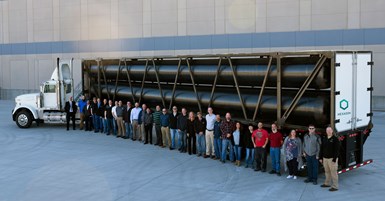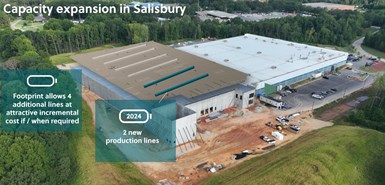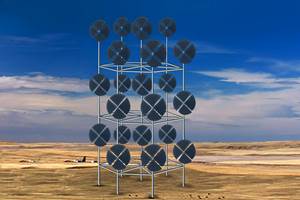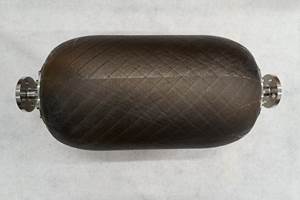Composites reinvent energy
Celebrating National Composites Week 2024, CW looks at how composites are being used to provide the next generation of energy.
(Top left, clokwise) RivGen hydrokinetic turbine, Carbon4Tank hydrogen storage using towpreg, nuclear fusion reactor and the Noor III solar plant. Source | OPRC, Voith HySTech, the ITER project and the U.N. Environment Program.
Composites have long enabled a wide range of energy production — from thermoplastic composite pipe used in oil & gas applications to wind turbines that can now output 18 megawatts of electricity using 140-meter-long wind blades. And composites continue to play a role in the energy transition required to save our planet. Hannah Mason published a 2024 market summary on composites in energy and here is my list of 8 noteworthy composites trends and developments in energy:
1. CFRP tanks transport/store renewable natural gas (RNG)
When produced from organic waste, RNG can be carbon negative. Type 4 pressure vessels made using carbon fiber-reinforced epoxy are enabling its transport from remote locations and subsequent use in vehicles such as heavy-duty trucks powered by Cummins’ new X15N engine.
This is boosting demand for CFRP Mobile Pipeline products made by Hexagon Agility (Costa Mesa, Calif., U.S.), a business of Hexagon Composites (Ålesund, Norway), including its 53-foot-long Titan 53 modules —comprising four Type 4 cylinders storing 7,420 kilograms of RNG — as well as smaller Type 4 storage tanks onboard RNG trucks. Hexagon Composites decided more than 15 years ago to pursue composite cylinders and modules to dramatically increase the volume of compressed gases that could be transported. The company is now increasing its Mobile Pipeline capacity by 40% at its Lincoln, Nebraska, U.S. site and adding 2 cylinder production lines at the Hexagon Agility site in Salisbury, N.C., U.S. This first cylinder production at the site includes 2 lines in 2024 with room to add up to four more lines as needed. Read more: “Hexagon Agility … boost production of composite cylinders”.
2. Lightweight solar panels on Earth and in space
EconCore (Leuven, Netherlands), a manufacturer of honeycomb sandwich material production technology, and Solarge (Weert, Netherlands), a producer of lightweight, sustainable solar panels, launched a new lightweight, fully circular solar panel in 2023 that reduces the weight of solar installations by up to 65% for rooftops. Read more: “… lightweight, sustainable solar panels”.
Satellites are prepped for deployment within a rocket's payload bay and feature rapidly manufactured composite deployable solar arrays. Source | Kerberos Engineering
Meanwhile, deployable solar arrays for satellites are being made with TeXtreme (Borås, Sweden) 0/90 woven spread tow fabrics, meeting stiffness, coefficient of thermal expansion (CTE) and outgassing requirements while reducing resources required for manufacturing by 90% compared to conventional techniques. Read more: “Ultra-thin woven fabric ... in satellite solar array manufacturing”.
3. RTM, braided fabric for more cost-effective underwater turbines
Hawthorn Composites manufactures foils (left) and struts (bottom right) for assembly into the RivGen underwater hydrokinetic turbine system. Photo Credit: CW, OPRC
Ocean Renewable Power Co.(ORPC, Portland, Maine, U.S.) develops hydrokinetic turbines to generate electricity using river currents and ocean tides. The company’s RivGen and TidGen systems feature a modular design employing curved carbon fiber composite foils suspended by glass fiber composite triangular struts connected to a steel shaft. The company replaced its original hand layup prepreg process with dry fabric and resin transfer molding (RTM) to cut manufacturing costs for the struts by 20%, and reduce cost and cycle time for the foil by 35% and 70%, respectively. Read more: “… faster, cost-effective manufacture for hydrokinetic turbine components”.
4. ZeroAvia, Verne explore cryo-compressed tanks using carbon fiber for zero-emission aircraft
ZeroAvia is certifying H2-powered engines for zero-emission aircraft and working with Verne to evaluate its cryo-compressed hydrogen storage tanks. Source | ZeroAvia, Verne
ZeroAvia (Hollister, Calif., U.S.) believes hydrogen (H2)-electric powertrains are the only viable, scalable solution for zero-emission aviation. Certification of its ZA600 powertrain for planes with up to 20 seats is in progress, targeting the end of 2025, followed by the larger ZA2000 for 40–80 seat aircraft by 2027. ZeroAvia has nearly 2,000 pre-orders from major global airlines and partnerships with major aircraft OEMs including Airbus.
Verne (San Francisco, Calif., U.S.) is developing cryo-compressed H2 (CcH2) which stores H2 as a very cold compressed gas in Type 3 carbon fiber/epoxy-overwrapped aluminum tanks. Typically CcH2 tanks are dewars, with the inner tank insulated by a vacuum inside a stainless steel jacket. Verne claims CcH2 can achieve 40% greater usable density than liquid hydrogen (LH2 at -253C) and 200% greater usable density than 350-bar compressed gas H2 (CGH2). Thus enabling longer flights. (See “CcH2: the best solution for storage and refueling stations?”) The two companies will evaluate the use of CcH2 onboard aircraft and CcH2 refueling from CGH2 and LH2 sources.
5. CGH2 tank capacity, conformable tanks, towpreg
According to the Hydrogen Council, 79,000 H2-powered fuel cell vehicles were on the roads in 2023. These use compressed gas H2 (CGH2) stored in Type 4 carbon fiber/epoxy wrapped tanks, and manufacturer Hexagon Purus (Oslo, Norway) has reported its 2024 revenues are up 67% in Q1 and 60% in Q2 versus 2023. This growth includes CGH2 infrastructure (distribution, mobile refueling, stationary storage) as well as mobility, including new contracts for bus (New Flyer, Gillig) and heavy trucks (Toyota).
“Hydrogen in a Box” prototype at 2024 Farnborough Air Show. Source | Polar Technology Management Group
However, there is also a push to develop conformable tanks that better fit into the same space as batteries for a standardized electric vehicle (EV) platform. Polar Technology Management Group (Eynsham, Oxfordshire, U.K.) debuted a prototype of its “Hydrogen in a Box” solution at the 2024 Farnborough International Air Show (July 22-26). This multi-chambered storage vessel is said to offer 25% greater volumetric efficiency than current Type 3 and Type 4 CGH2 storage tanks, enabling a more distributed storage solution which also could have promise for H2-powered aircraft. (See “Polar Technology develops innovative solutions for hydrogen storage”.)
Another key trend in Type 4 tank manufacturing is the switch from wet filament winding to using towpreg. Voth HySTech (Garching bei München, Germany) has certified its 700-bar Carbon4Tank with a 350-liter capacity per UNECE R 134 regulations. “We have a high degree of control over the fiber impregnation process to minimize deviations in the material properties, so that the tank has less deviations in its properties,” says Carolin Cichosz, CTO of Voith HySTech. “This enables a more accurate margin of safety in design and a 15% material reduction. The fibers also don’t slip as much in radius areas during winding, which also increases our precision, and we can achieve winding speeds that are 4-6 times faster than wet winding.” Read more: “Composites end markets: Pressure vessels (2024)”.
6. Wabash, Purdue develop composite trailer that captures power
Heavy truck trailer manufacturer Wabash National Corp. (Lafayette, Ind., U.S.) and Purdue University (West Lafayette) are exploring a composite trailer that captures electricity from vibrations, heat and airflow. The project is investigating ways to harvest electricity from a trailer’s normal operation, incuding the vibration of the suspension system and aeroelastic vibrations of the composite trailer panels. Even if the amount of power generated is small, it could help reduce the size of batteries required for all of EV trucks.
7. Ceramic matrix composites (CMC) enable next-gen nuclear power
BJS Ceramics and BJS Composites (Gersthofen, Germany) make their own SiC fiber, branded Silafil, and infiltrate that and carbon fiber with Silafil pre-ceramic polymer as a matrix to create Keraman CMC materials and parts. The company is also developing a proprietary process to 3D print CMC parts using chopped SiC or carbon fibers in slurry, advancing toward very long fibers.
“We are seeing increased demand across the aerospace and defense sectors, but also from the energy industry, including nuclear fission and fusion,” says BJS co-founder Jutta Schull, “where cooling pumps cannot fail.” CMC provides the ultimate durability, ensuring safety and continued operation in extremely high temperatures and harsh conditions. “Due to their thermal resistance, high damage tolerance and radiation resistance, SiC/SiC components can double the electricity generation from fusion reactors — according to findings of our customers.” (See “JEC World 2024 highlights: Thermoplastic composites, CMC and novel processes”.)
Fusion reactor. Source | NCC
SiC/SiC composites are also being developed at the National Composites Centre (NCC, Bristol, U.K.) because they enable reactors to operate at higher temperatures for improved thermal efficiency, greatly increasing the commercial viability of fusion energy production (see “NCC … to develop fusion-grade SiC/SiC composites”). Although power from nuclear fusion is many decades away, its potential is huge, offering four times more energy per kilogram of fuel than fission (current nuclear power plants) and nearly four million times more energy than burning oil or coal — but without any carbon emissions.
In the meantime, nuclear fission microreactors are being advanced to help battle climate change now. Nuclear microreactors are small yet generate up to 20 megawatts of power. They are also self-adjusting, compact, scalable, versatile and transportable, but currently constrained by traditional materials. The U.S. Dept. of Energy’s Argonne National Laboratory (Lemont, Ill.) is working to enable next-generation nuclear microreactors through material innovations including CMCs.
8. CMC for solar plants
SRI (Menlo Park, Calif., U.S.) is an independent nonprofit scientific and R&D organization with offices across the U.S. and is part of a U.S. Department of Energy project to improve CMC for solar plants. These concentrate sunlight to heat molten salt, which then stores energy. However, the process is most efficient above 700°C. Traditional containment materials corrode and degrade in these conditions.
SRI has developed novel ceramic matrix composites (CMC) aimed to enable high-concentration solar plants and other renewable energy systems. Source | SRI
SRI has developed an “infiltration-free” process that reportedly produces CMC with increased durability and resistance to this corrosion, but also manufacturing costs that are 50% lower than traditional CMC. The latter typically incorporate carbon fibers or silicon carbide fibers for toughness, and infiltrate these with liquid silicon matrix at very high temperatures. Instead, SRI uses a precursor resin/polymer with ceramic particles which chemically bond to the fibers. When the composite is heated to form the CMC, this bonding helps resist crack and void formation, meaning the time-consuming ceramic infiltration process — typically used to heal cracks and voids that form during thermal processing — is no longer required. SRI is also working to use its novel CMC in systems that recover and reuse waste heat in energy-intensive processes like steel manufacturing.
Walter E.C. Pritzkow Spezialkeramik helped produce this prototype OCMC solar receiver (top) used in solar plants, which function similarly to the Noor III solar plant in Morocco shown here. Source | Walter E. C. Pritzkow Spezialkeramik, the U.N. Environment Program
The temperature and efficiency advantages of CMC were highlighted in “A new era for ceramic matrix composites.” That 2023 article featured Walter E.C. Pritzkow Spezialkeramik, a small company located near Stuttgart, Germany that makes Keramikblech aluminum oxide (Ox) fiber-reinforced Ox matrix parts. Company founder Walter Pritzkow explains that he prefers Ox/Ox CMC (or OCMC) because SiC/SiC and C/SiC are much more complex materials and require longer processing. Although the latter can resist temperatures up to 1600°C, Pritzkow’s OCMC parts are typically used at 1,150-1,200°C, with a maximum of 1,280°C. Not mentioned in the article is an innovative volumetric solar receiver that he helped to prototype using OCMC. Also used in solar plants, these solar absorbers receive solar energy collected by a large field of heliostats. Air is heated within the absorber/receiver and then directed to storage or a gas turbine producing electricity. The complex shapes that Pritzkow makes using OCMC and their ability to increase process efficiency offer interesting possibilities for other future energy applications.
About National Composites Week
The goal of National Composites Week (NCW) is to celebrate and bring attention to the ways that composite materials and composites manufacturing contribute to the products and structures that shape the American manufacturing landscape today.
NCW takes place each year in the final week of August and celebrates a specific theme.
The 2024 theme was Composites Reinvent the World. See what companies and individuals shared on LinkedIn and read more from the CW editorial team:
Related Content
Drag-based wind turbine design for higher energy capture
Claiming significantly higher power generation capacity than traditional blades, Xenecore aims to scale up its current monocoque, fan-shaped wind blades, made via compression molded carbon fiber/epoxy with I-beam ribs and microsphere structural foam.
Read MoreNovel composite technology replaces welded joints in tubular structures
The Tree Composites TC-joint replaces traditional welding in jacket foundations for offshore wind turbine generator applications, advancing the world’s quest for fast, sustainable energy deployment.
Read MoreNCC reaches milestone in composite cryogenic hydrogen program
The National Composites Centre is testing composite cryogenic storage tank demonstrators with increasing complexity, to support U.K. transition to the hydrogen economy.
Read MoreComposites end markets: Automotive (2024)
Recent trends in automotive composites include new materials and developments for battery electric vehicles, hydrogen fuel cell technologies, and recycled and bio-based materials.
Read MoreRead Next
VIDEO: High-volume processing for fiberglass components
Cannon Ergos, a company specializing in high-ton presses and equipment for composites fabrication and plastics processing, displayed automotive and industrial components at CAMX 2024.
Read More“Structured air” TPS safeguards composite structures
Powered by an 85% air/15% pure polyimide aerogel, Blueshift’s novel material system protects structures during transient thermal events from -200°C to beyond 2400°C for rockets, battery boxes and more.
Read MorePlant tour: Daher Shap’in TechCenter and composites production plant, Saint-Aignan-de-Grandlieu, France
Co-located R&D and production advance OOA thermosets, thermoplastics, welding, recycling and digital technologies for faster processing and certification of lighter, more sustainable composites.
Read More






































